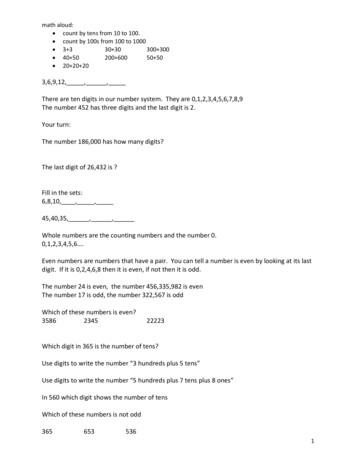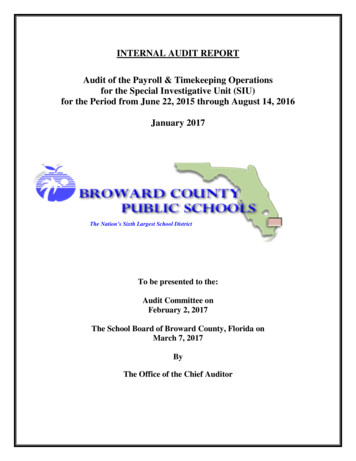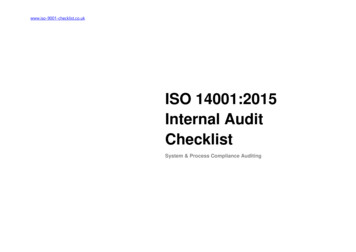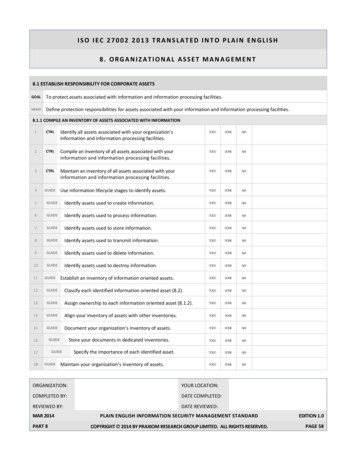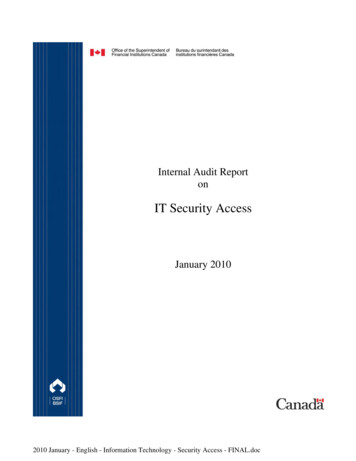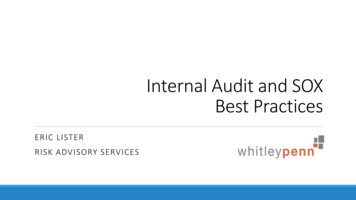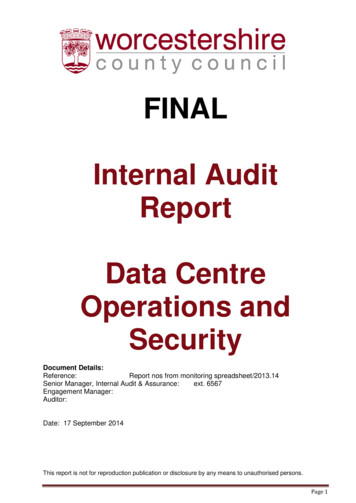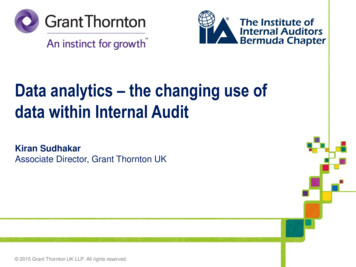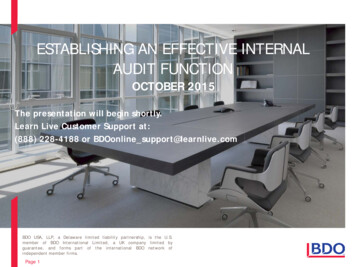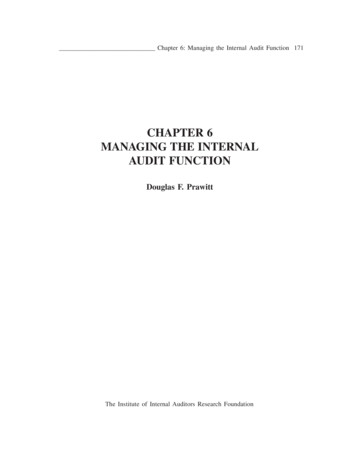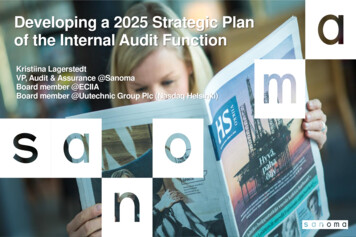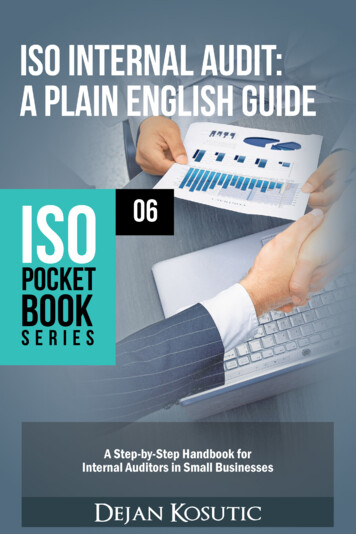
Transcription
ISO Internal Audit:A Plain English Guide1
Also by Dejan Kosutic:Secure & Simple: A Small-Business Guide to Implementing ISO27001 On Your Own9 Steps to Cybersecurity: The Manager’s Information SecurityStrategy ManualBecoming Resilient: The Definitive Guide to ISO 22301ImplementationISO 27001 Risk Management in Plain EnglishISO 27001 Annex A Controls in Plain EnglishPreparing for ISO Certification Audit: A Plain English GuideManaging ISO Documentation: A Plain English GuidePreparations for the ISO Implementation Project: A Plain EnglishGuide2
Dejan KosuticISO Internal Audit:A Plain English GuideA Step-by-Step Handbook forInternal Auditors in Small BusinessAdvisera Expert Solutions LtdZagreb, Croatia3
Copyright 2017 by Dejan KosuticAll rights reserved. No part of this book may be reproduced, stored ina retrieval system or transmitted in any form or by any means,electronic, mechanical, photocopying, recording or otherwise, withoutwritten permission from the author, except for the inclusion of briefquotations in a review.Limit of Liability / Disclaimer of Warranty: While the publisher andauthor have used their best efforts in preparing this book, they makeno representation or warranties with respect to the accuracy orcompleteness of the contents of this book and specifically disclaim anyimplied warranties of merchantability or fitness for a particularpurpose. This book does not contain all information available on thesubject. This book has not been created to be specific to anyindividual’s or organization’s situation or needs. You should consultwith a professional where appropriate. The author and publisher shallhave no liability or responsibility to any person or entity regarding anyloss or damage incurred, or alleged to have been incurred, directly orindirectly, by the information contained in this book.First published by Advisera Expert Solutions LtdZavizanska 12, 10000 ZagrebCroatiaEuropean Unionhttp://advisera.com/ISBN: 978-953-8155-03-1First Edition, 20174
ABOUT THE AUTHORDejan Kosutic is the author of numerous articles, video tutorials,documentation templates, webinars, and courses about ISO27001, ISO 22301 and other ISO standards. He is the author ofthe leading ISO 27001 & ISO 22301 Blog, and has utions,government agencies, and IT companies implement informationsecurity management according to these standards. He holdsnumerous certificates, among them ISO 27001 Lead Auditorand ISO 9001 Lead Auditor.Click here to see his LinkedIn profile5
TABLE OF CONTENTSABOUT THE AUTHOR . 5PREFACE. 8ACKNOWLEDGMENTS . 101INTRODUCTION . 111.1 WHY COMPANIES NEED INTERNAL AUDITS . 111.2 ISO 19011 – A STANDARD FOCUSED ON AUDITING . 121.3 WHO SHOULD READ THIS BOOK? . 131.4 HOW TO READ THIS BOOK. 131.5 WHAT THIS BOOK IS NOT . 141.6 ADDITIONAL RESOURCES . 152BASIC THINGS ABOUT THE INTERNAL AUDIT . 162.1 INTERNAL VS. EXTERNAL AUDIT . 162.2 THE MAIN PURPOSE OF THE INTERNAL AUDIT . 172.3 INTERNAL AUDIT REQUIREMENTS IN ISO STANDARDS . 182.4 SKILLS, COMPETENCES, AND QUALIFICATIONS FOR INTERNALAUDITOR . 192.5 AUDIT FINDINGS: NONCONFORMITIES AND OBSERVATIONS . 212.6 MAJOR AND MINOR NONCONFORMITIES . 232.7 INTERNAL AUDIT VS. RISK ASSESSMENT . 252.8 INTERNAL AUDIT VS. GAP ANALYSIS . 263ORGANIZING AN INTERNAL AUDIT . 283.1 OPTIONS FOR PERFORMING THE INTERNAL AUDIT AND TOPMANAGEMENT ROLE. 283.2 THREE KEY DOCUMENTS FOR ORGANIZING THE INTERNALAUDIT . 293.3 INTERNAL AUDIT PROCEDURE . 303.4 ANNUAL AUDIT PROGRAM . 313.5 AUDIT PLAN FOR AN INDIVIDUAL AUDIT. 333.6 SUCCESS FACTORS . 346
4STEPS IN THE INTERNAL AUDIT PROCESS . 354.1 SEVEN STEPS FOR PERFORMING THE INTERNAL AUDIT. 354.2 PERFORMING DOCUMENT REVIEW . 364.3 CREATION OF THE INTERNAL AUDIT CHECKLIST . 384.4 WRITING THE INTERNAL AUDIT REPORT . 414.5 INITIATING CORRECTIVE ACTIONS . 424.6 CORRECTIVE ACTION FOLLOW-UP . 434.7 SUCCESS FACTORS . 445PERFORMING THE MAIN PART OF THE AUDIT . 455.1 MAKING ASSUMPTIONS: THE BIGGEST AUDITOR MISTAKE . 455.2 PURPOSE OF THE OPENING MEETING . 465.3 TECHNIQUES FOR FINDING EVIDENCE DURING THE ON-SITEAUDIT . 475.4 SAMPLING THE RECORDS. 485.5 RECORDING THE EVIDENCE DURING THE AUDIT. 495.6 INTERVIEWING TECHNIQUES FOR THE AUDIT . 505.7 CLOSING MEETING . 525.8 SUCCESS FACTORS . 526 BONUS CHAPTER: DEVELOPING AN AUDITINGCAREER . 546.1 HOW TO BECOME A CERTIFICATION AUDITOR . 546.2 WHAT DO THE LEAD AUDITOR COURSE AND LEAD IMPLEMENTERCOURSE LOOK LIKE? . 556.3 LEAD AUDITOR COURSE VS. LEAD IMPLEMENTER COURSE –WHICH ONE TO GO FOR?. 56BIBLIOGRAPHY . 58INDEX . 607
PREFACEWhen we published our internal auditor online courses onAdvisera’s eTraining website, we soon realized that there is ahuge demand for this topic. And, although the students arequite satisfied with the courses, it became obvious that manywere in need of some written materials that would take themthrough the internal audit.This is why I have written this shorter book, a part of thehandbook series, which is focused solely on how to perform theinternal audit. I have written this book in such a way so that it isperfectly acceptable for any management system, including ISO9001, ISO 14001, ISO 27001, ISO 20000, ISO 22000, OHSAS18001, ISO 13485, and IATF 16949.This book, ISO Internal Audit: A Plain English Guide, is basedmostly on the above-mentioned internal auditor online courses,and has been edited with only a few smaller details. So, if youcompare the curriculum from the internal auditor courses, you’llsee the same sections here, with almost the same text – as Imentioned, the text was adapted in a way that it is readablefrom any ISO standard point of view.So, why have two learning materials with almost the same text?Because I wanted to provide a quick, written reference forpeople who are performing the audit, who might not have thetime to join the course each time they want to remindthemselves of some detail. I would say that both attending theinternal auditor course and reading this book will give you aperfect combination of learning through visual media, andreferring to textual media for details.8
PrefaceYou might also be puzzled by the fact that this book is rathershort, whereas there are other books on ISO audits on themarket that are much more lengthy and detailed. Is it reallypossible to explain such a complex subject in a short book likethis? Well, there are three answers for this:First, this book is focused on internal audits only, which aremuch simpler than certification audits; second, this book iswritten for internal auditing in smaller companies – therefore, Ihave intentionally simplified the steps so that your auditing canbe done rather quickly, and left out most of the elements thatwould be needed only for larger companies.Third, and most important, I followed my company mission:“We make complex frameworks easy to understand and simpleto use.” In other words, it is easy to complicate things, but it isdifficult to make things easy to understand. So, when you startreading this book you’ll notice I eliminated all the hard-tounderstand talk, all the unnecessary details, and focused onwhat exactly needs to be done, in a language understandablefor beginners with no prior experience in ISO internal audits.So, rest assured: if you are an auditor in a smaller organization,by using this book you will be able to perform your first internalaudit – it will take you step by step through the whole process,without stress.9
ACKNOWLEDGMENTSSpecial thanks to Strahinja Stojanovic, who has done a great jobof developing the ISO 9001 and ISO 14001 internal auditoronline courses that serve as the basis for this book. I’m alsograteful to Mark Hammar for his text about gap analysis.10
1INTRODUCTIONWhy is the internal audit so important for management systems,and how can it be useful for the company? What will you find inthis book? And, is this book the right choice for you?Note: This book covers the internal audit process for all ISOmanagement standards – ISO 9001, ISO 14001, ISO 27001, ISO20000, and ISO 13485, but also OHSAS 18001 and IATF 16949(former ISO/TS 16949) – so when I refer to “ISO standard” orsimply “standard,” by this I mean any of these standards. Also,when I mention “management system,” I mean the system thatis compliant with any of these standards – e.g., QualityManagement System according to ISO 9001, InformationSecurity Management System according to ISO 27001, etc.1.1 Why companies need internal auditsFrom my experience as a certification auditor, the sad truth isthat most organizations perform internal audits just to satisfythe certification body.Such internal audits usually uncover a few minornonconformities, which do not get deep into the real problemsof the company’s management system. And this is veryunfortunate because this is a waste of time – if companies haveinvested the time of their internal auditors to perform such jobs,they should gain some benefits out of it.The point with internal audits is that they should discoverproblems that would otherwise stay hidden and would thereforeharm the business. Let’s be realistic – it is human to make11
ISO Internal Audit: A Plain English Guidemistakes, so it’s impossible to have a system with no errors; it is,however, possible to have a system that improves itself andlearns from its mistakes. Internal audits are a crucial part of sucha system.On the positive side, as a certification auditor I did see someorganizations performing internal audits in the right way, andfor the right reasons. Although their employees did feel a littleuncomfortable about the internal auditor checking theiractivities, very soon they saw the benefits of such an approach –problems became transparent, and were resolved rather soon.How are these benefits of the internal audit achieved? Here aresome tips:1) The management should view the internal audit as oneof the best tools to improve the system, not only as ameans to get certified.2) The internal auditor should be the right person for thejob – this means he/she must be qualified, but alsomotivated and trained to perform this job.3) The internal audit should be performed in a positive way– the aim should be to improve your system, not toblame the employees for their mistakes.In this book I’ll explain how to achieve all this.1.2 ISO 19011 – A standard focused on auditingThere is an ISO standard that describes how to perform theaudits – it is called ISO 19011. It describes the auditingprinciples, how to manage the audit program, the requiredactivities during the audit, and the necessary knowledge forauditors.12
IntroductionThe principles of ISO 19011 can be used for any type of auditing– a certification audit, an audit of suppliers, and of course, theinternal audit.In this book I included all the main principles of ISO 19011, andscaled them down for the purpose of the internal audit –because the internal audit is not as complex as a certificationaudit, I have simplified many of the guidelines from ISO 19011to make them easy to use when performing the internal audit ina small company.1.3 Who should read this book?This book is written primarily for beginners in internal auditingand for people with moderate knowledge about internal audits– I structured this book in such a way that someone with noprior experience or knowledge about internal audits can quicklyunderstand how the whole audit process works, and what thesteps are for its successful completion.On the other hand, if you do have experience with internalaudits, but you feel that you still have gaps in your knowledge,you’ll also find this book helpful.1.4 How to read this bookThis book is written as a step-by-step guide for auditing, andChapters 2 to 5 should be read in the exact order they arewritten, because this sequence represents the best way ofplanning and performing an internal audit.Here are some additional features of this book that will make iteasier for you to read it and use it in practice:13
ISO Internal Audit: A Plain English Guide Some sections contain tips for free tools and fordocuments that are to be used during the internal audit. At the ends of the most important chapters, you’ll see asection called “Success factors,” which will emphasizewhat you need to focus on. At the end of this book you’ll see a chapter that will helpyou decide whether you want to pursue your career inbecoming a certification auditor.1.5 What this book is notThis book is about the internal audit process; it is not about howto certify your company or how to implement the standard – theimplementation process is quite lengthy and involves a lot ofsteps that are outside the scope of this book.This book won't give you finished templates for internal auditpolicies, procedures, and plans; however, this book will explainwhich documents you will need to perform an internal audit,and how to structure those documents.This book is not a copy of any ISO standard – you cannotreplace reading the standard by reading this book. This book isintended to explain how to interpret the ISO clauses about theinternal audit, and describe best practices when performing theinternal audit.Because this book is focused on internal auditing, it does notexplain other elements of ISO standards like documentmanagement, risk management, operations, measurement, etc.14
Introduction1.6 Additional resourcesHere are some resources that will help you, together with thisbook, to learn about internal auditing: ISO online courses – free online trainings for ISO 9001,ISO 14001, and ISO 27001 internal auditors. ISO 27001 free downloads, ISO 9001 free downloads,and ISO 14001 free downloads – a collection of whitepapers, checklists, diagrams, templates, etc. Conformio – a cloud-based document managementsystem (DMS) and project management tool focused onISO standards that can be used for auditing purposes. ISO 9001 Internal Audit Toolkit – a set of all thedocumentation templates that are required forperforming the internal audit; similar toolkits exist forother ISO standards. Official ISO webpage – here you can purchase an officialversion of any ISO standard.15
2BASIC THINGS ABOUT THEINTERNAL AUDITIn this chapter I’ll give you an overview of the internal audit inthe ISO world – its main purpose, how it is different fromexternal (certification) auditing, the exact requirements of ISOstandards, how you should select an internal auditor, the mainoutputs of the internal audit job, etc.2.1 Internal vs. external auditAs mentioned earlier, ISO 19011 is a standard that describeshow to perform audits – this standard defines an internal auditas “conducted by, or on behalf of, the organization itself formanagement review and other internal purposes.” This basicallymeans that the internal audit is performed by your ownemployees, or you can hire someone from outside of yourcompany to perform the audit on behalf of your company.On the other hand, the external audit is done by a third party ontheir own behalf – in the ISO world, the certification audit is themost common type of external audit done by the certificationbody.You can also understand the difference between internal andexternal audit in the following way: the results of the internalaudit will be used only internally in your company, while theresults of the external audit will be used externally as well – forexample, if you pass the certification audit you will get acertificate, which will be used publically. On the other hand, the16
BASIC THINGS ABOUT THE INTERNAL AUDITfocus of the internal audit will be on how to improve yourmanagement system, as I’ll explain in the next section.2.2 The main purpose of the internal auditUnfortunately, the purpose of the internal audit is very oftenmisunderstood – it is usually perceived as a bureaucratic activitywith no real benefit. However, the main purpose of the internalaudit is to help improve the way your system is managed in yourcompany – this improvement is possible because the auditor isin the perfect position to see what’s going wrong, and byhaving this deeper insight, he or she can help resolve theseproblems.The benefits of the internal audit are manifold. In addition tothe improvement of your management system, the internalaudit is the key source of information for the managementreview. Also, a very important aspect is that through internalaudit the employee awareness is raised for, e.g., quality issues inyour QMS (Quality Management System) or information securityissues in your ISMS (Information Security Management System),as well as their participation in improving the managementsystem.To be able to achieve all this, the internal auditor must approachthis whole job in a positive way – this means she cannot insultpeople if she sees that they have made a mistake; rather, sheshould explain the mistake in a very diplomatic way, and helpthem improve the way they do things.I’ll explain how the auditor can achieve this in the followingchapters.17
ISO Internal Audit: A Plain English Guide2.3 Internal audit requirements in ISO standardsThe latest revisions of ISO 9001, ISO 14001, ISO 27001, ISO22301, ISO 13485, and IATF 16949 are aligned and theirrequirements for the internal audit are basically the same: Internal audits must be performed at planned intervals –typically, once a year every department within the scopeof your management system must be audited. The auditor must check out whether your activities arecompliant with the standard, as well as with your ownpolicies, procedures, and other documentation. The auditor must also check if the system is properlymaintained, meaning that all the documentation is up todate, that all the KPIs are monitored, that correctiveactions are performed, etc. The company must write the audit program – I’ll explainlater what this document stands for. The company must define the scope of the audit – thatis, which departments, processes, or activities will becovered. Typically, you have to cover the whole scope ofyour management system within one year. You also have to define the audit criteria – that is,against which requirements will your managementsystem be audited. Typically, the audit will be madeagainst the standard, against your own documentation,and against some third-party requirements for yourmanagement system (for example, this could be somelegislation in your country, working instructions given byyour partners, etc.).18
(This part of the book is not displayed in the free preview)
BIBLIOGRAPHYIATF 16949:2016, Quality management system requirements forautomotive production and relevant service parts organizations,International Automotive Task Force, 2016ISO 9001:2015, Quality management systems – Requirements,International Organization for Standardization, 2015ISO 13485:2016, Medical devices – Quality managementsystems – Requirements for regulatory purposes, InternationalOrganization for Standardization, 2016ISO 14001:2015, Environmental management systems –Requirements with guidance for use, International Organizationfor Standardization, 2015ISO 19011:2011, Guidelines for auditing management systems,International Organization for Standardization, 2011ISO/IEC 20000-1:2011, Information technology – Servicemanagement – Part 1: Service management systemrequirements, International Organization for Standardization,2011ISO 22301:2012, Societal security – Business tionalOrganization for Standardization, 2012ISO/IEC 27001:2013, Information technology – Securitytechniques – Information security management systems –Requirements, International Organization for my/blog/ ISO 27001 & ISO22301 Blog, Advisera.com58
o-27001-internal-auditorcourse/ ISO 27001 Internal Auditor Course, Advisera.com59
INDEXaccreditation, 12activities, 29audit conclusions, 41audit criteria, 18, 21, 32, 41audit findings, 21, 41audit plan, 28, 33, 34, 35, 36,37, 46audit program, 29, 30, 31, 32,34banks, 28business continuity, 58certification body, 54, 55closing meeting, 52cloud, 15consultant, 29, 61corrective actions, 18, 21, 36,37, 38, 42, 43, 45coursescourse, 55, 56document managementsystem, 15document review, 35, 36, 37,38, 40, 45IATF 16949, 8, 11, 18Information security, 58interested parties, 40internal audit, 28, 29, 40internal audit checklist, 35, 38,40, 61internal audit procedure, 30,31Internal audit report, 37, 41,42internal auditor, 28, 29Internal auditor course, 21ISMS, 55ISO, 58ISO 13485, 8, 11, 18ISO 14001, 8, 11, 15, 18, 32,58, 61ISO 19011, 12, 16, 58ISO 20000, 8, 11ISO 22301, 2, 58ISO 27001, 2, 8, 11, 15, 18,22, 29, 32, 39, 40, 54, 56,58, 59, 61ISO 9001, 8, 11, 15, 18, 41,58, 61larger organizationslarge organizations, 28Lead Auditor, 54, 55legislation, 29main audit, 35, 36, 37, 38, 39,40, 46Major nonconformities, 24minor nonconformities, 23, 24,25nonconformity, 21, 22, 23, 24,25, 41, 42, 43, 45, 48, 51observations, 22, 42OHSAS 18001, 8, 11opening meeting, 46team leader, 32, 34top management, 29work documents, 35, 4060
ISO Internal Audit: A Plain English GuideA Step-by-Step Handbook for Internal Auditors in SmallBusinessesThink and act like an experienced auditor with thiscomprehensive, practical, step-by-step guide to performinginternal audits against ISO 9001, ISO 14001, ISO 27001, or anyother ISO management standard.Auditor and experienced consultant Dejan Kosutic shares hisknowledge and practical wisdom with you in one invaluablebook. You will learn: Internal audit requirements in ISO standards Skills, competences,auditorsandqualificationsofinternal Which documentation is necessary for performing theinternal audit 7 steps for performing the internal audit How to develop the internal audit checklist How to collect the evidence and perform interviews How to write nonconformities and internal audit reports All this, and much more Written in easy-to-understand language, ISO Internal Audit: APlain English Guide is written for people who are performing aninternal audit for the first time and need clear guidance on howto do it. Whether you’re an experienced ISO practitioner or newto the field, it’s the only book you’ll ever need on the subject.61
handbook series, which is focused solely on how to perform the internal audit. I have written this book in such a way so that it is perfectly acceptable for any management system, including ISO 9001, ISO 14001, ISO 27001, ISO 20000, ISO 22000, OHSAS 18001, ISO 13485, and IATF 16949. This book, ISO
